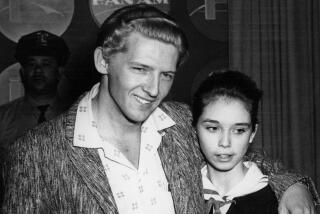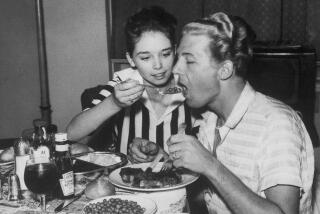A 3-hit-shy Sly & the Family Stone
Sly & the Family Stone’s debut album four decades ago was titled “A Whole New Thing” -- and how true it was musically speaking.
In the heart of rock’s most innovative decade, Stone (a former San Francisco radio DJ whose real name is Sylvester Stewart) unleashed a vision in that album that would send an electrical charge through R&B;, pop, rock and, eventually, hip-hop.
Stone was the link between James Brown and Prince, and his vision was as much social as musical. His Family Stone band was a racially mixed, coed outfit, complete with a hippie-like vibe. The group initially included Larry Graham on bass, Greg Errico on drums, Jerry Martini on sax, Cynthia Robinson on trumpet, Freddy Stone on guitar, Rosie Stone on keyboards and Stone himself on vocals, keyboards and guitar.
Epic/Legacy has just released seven Sly & the Family Stone studio collections -- each remastered with bonus tracks and liner notes by such seasoned writers as Bud Scoppa, Barney Hoskyns and Joel Selvin. The CDs are available individually or in a limited-edition boxed set. Unfortunately, three of the group’s most celebrated numbers -- “Hot Fun in the Summertime,” “Thank You (Falettinme Be Mice Elf Agin)” and “Everybody Is a Star” -- aren’t included because they appeared on a “greatest hits” package that isn’t represented.
But the set does include the two Sly Stone albums that reflect extremes of emotion as drastic as any back-to-back releases by an artist: the joyful, upbeat “Stand!” and the dark, paranoid “There’s a Riot Goin’ On.” The difference in tone remains astounding.
Sly & the Family Stone
“The Collection”
Epic/Legacy
The back story: There are moments of promise in Stone’s 1967 debut, but the breakthrough is in the optimism, exuberance and sheer musical uprising found in his follow-up work, 1968’s “Dance to the Music.” After more groundwork on the third album, “Life,” Stone and the band delivered a masterpiece in 1969’s “Stand!,” which contained a dazzling string of hits, including “Everyday People” and “I Want to Take You Higher.”
Prince was 10 when “Everyday People” was a radio hit, and you can imagine him getting caught up in the energy and excitement; it is a key reason he later put together his own biracial, coed band. Prince’s fondness for playful spellings may also stem from “Falettinme.”
“Stand!” was such an irresistible force that it spent nearly two years on the national pop charts. When Stone followed the album with the smash single “Hot Fun,” he seemed invincible -- as potent a cultural force as Prince during his “Purple Rain” period. Sly’s “Greatest Hits” album, containing “Hot Fun” and “Thank You,” was released late in 1970 and it spent 20 more months on the charts.
With this setup, Stone’s next album was a severe disappointment for many fans. Released near the end of 1971, “There’s a Riot Goin’ On” contained little of the celebration or outreach of the group’s earlier work. Even now, it is helpful to know the conditions under which “Riot” was made to appreciate the bitterness, alienation and pain in the music.
Stone had slipped traces of disillusionment into earlier works, but they had been accompanied by a musical pulse so strong that it swept you along. Other artists have built albums around depression and paranoia -- think Neil Young’s “Tonight’s the Night” and Nine Inch Nails’ “The Fragile,” respectively -- without losing all contact with the listener. In “Riot,” however, the tone was so muted that it was hard at times to detect any pulse at all.
What we learned was that the music in “Riot” was a fairly accurate picture of Stone’s emotional state at the time. Writes Selvin in the “Riot” liner notes, “Sly’s personal life was tumbling out of control. He was doing a huge amount of drugs. He surrounded himself with thugs. He spent like a rajah and lived like decadent royalty ... Sly would corral musicians upstairs and keep them there, recording, literally, for days. The cast of players changed. Tapes disappeared. Songs were worked on one day and lost forever the next. Things were done over at different tempos.”
Detecting the delicate sensibilities of the album, some critics hailed it as a second masterpiece for Stone and that view has been widely accepted since. Some fans even rank it over “Stand!”
Before the disappearing act of recent years, Stone recorded other albums (two of which are contained in the set), but none of it comes close to his best work. Listening to “Stand!” and “Riot” again in these remastered versions is a remarkable experience, regardless of your verdict on which is the true masterpiece.
One more thing / The Doors: There’s also much debate over which of the Doors’ six studio albums was the L.A. group’s finest hour. The contenders: “The Doors” (1967), “Morrison Hotel” (1970) and “L.A. Woman” (1971). Rhino last year released the albums (remixed and with bonus tracks) in a 40th anniversary boxed set, “Perception.” The albums are now available individually, both in CD and as digital downloads.
Backtracking, a biweekly feature, highlights CD reissues and other historical pop music items.
More to Read
The biggest entertainment stories
Get our big stories about Hollywood, film, television, music, arts, culture and more right in your inbox as soon as they publish.
You may occasionally receive promotional content from the Los Angeles Times.






